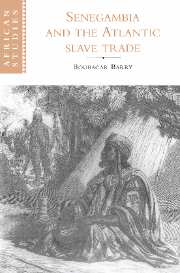Book contents
- Frontmatter
- Contents
- Preface
- Map
- I Senegambia from the fifteenth to the seventeenth century: a haven for incoming populations, a station for migrants on the move
- 1 Senegambia in the fifteenth and sixteenth centuries: dependence on the Sudan and the Sahara
- 2 Social dynamics in Senegambia
- 3 The Atlantic trading system and the reformation of Senegambian states from the fifteenth to the seventeenth century
- 4 The partition of the Senegambian coast in the seventeenth century
- II Senegambia in the eighteenth century: the slave trade, ceddo regimes and Muslim revolutions
- III Senegambia in the first half of the nineteenth century: legitimate trade and sovereignty disputes
- IV Senegambia in the second half of the nineteenth century: colonial conquest and resistance movements
- Conclusion
- Notes
- Bibliography
- Index
- Other books in the series
4 - The partition of the Senegambian coast in the seventeenth century
Published online by Cambridge University Press: 31 October 2009
- Frontmatter
- Contents
- Preface
- Map
- I Senegambia from the fifteenth to the seventeenth century: a haven for incoming populations, a station for migrants on the move
- 1 Senegambia in the fifteenth and sixteenth centuries: dependence on the Sudan and the Sahara
- 2 Social dynamics in Senegambia
- 3 The Atlantic trading system and the reformation of Senegambian states from the fifteenth to the seventeenth century
- 4 The partition of the Senegambian coast in the seventeenth century
- II Senegambia in the eighteenth century: the slave trade, ceddo regimes and Muslim revolutions
- III Senegambia in the first half of the nineteenth century: legitimate trade and sovereignty disputes
- IV Senegambia in the second half of the nineteenth century: colonial conquest and resistance movements
- Conclusion
- Notes
- Bibliography
- Index
- Other books in the series
Summary
Right from the start of the seventeenth century, the Portuguese monopoly was challenged by the arrival, one after the other, of the Dutch, the English, and the French. These new European powers invaded the African coast, beginning the grand adventure that was to become the encirclement of Africa.
European powers began a lively competition, establishing their domination in Senegambia by setting up zones of influence jealously guarded by fortified trading posts along the coast. The entire Senegambian coastline was thus garrisoned with forts at Arguin, Saint Louis, Goree, Fort Saint James, Cacheu, and Bissao.
The principal business of these trading posts was to hold slaves in transit. For, as from the second half of the seventeenth century, the slave trade became the principal business of the European powers on the African coast. Intense slave trading necessarily required manhunts. These caused profound economic, political, and social crises. The slave trade, for example, engendered violence in inter-state relationships, the militarization of regimes, and the advancement of militant Islam. And from the end of the seventeenth century, Senegambia became the venue for a vast marabout-led movement intent on unifying the states of the Senegal valley in order to combat the negative effects of the slave trade, already manifest in the region.
Trading posts and the partition of coastal Senegambia
The reshaping of the political landscape went hand in hand with resurgent violence between states and the development of the slave trade, which accelerated the political dismemberment of Senegambia.
- Type
- Chapter
- Information
- Senegambia and the Atlantic Slave Trade , pp. 46 - 54Publisher: Cambridge University PressPrint publication year: 1997

